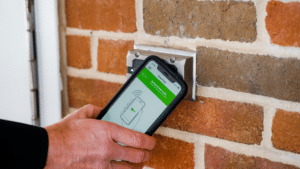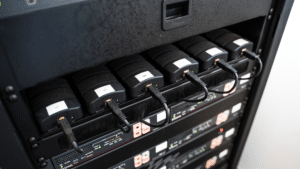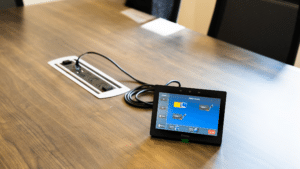Environmental sensors collect a range of information in environments, such as temperature, air quality, noise, and motion. As the use of vapes in schools increases, they are becoming increasingly important for vape detection.
Of course, understanding environmental sensors is important to successful vape detection. With the right approach to the installation and use of environmental sensors at your school, you’ll be able to get the most value out of your investment.
Now, let’s answer some of the most common questions about environmental sensors for vape detection at schools, how they work, and their benefits.
What Is an Environmental Sensor?
An environmental sensor collects multiple types of readings within an environment to help facilities notice when things are amiss. The Verkada environmental sensor, for example, monitors the following:
- Temperature
- PM 2.5
- TVOC
- Vape Detection
- Air Quality Index
- Humidity
- Noise
- Motion
To support vape detection efforts in schools, the sensor helps you identify abnormalities in air quality that signal a student, teacher, or staff member is vaping.
For example, you can place sensors for vaping in your school’s bathrooms. If a student vapes nearby, the device picks up traces of harmful chemicals within its range. At this point, it alerts the faculty, who can respond accordingly.
The Benefits of Environmental Sensors
You are not required to install environmental sensors in bathrooms or other areas of your school. However, research suggests many K-12 schools, colleges, and universities are doing so to enforce their policies on vape, drug, and cigarette use.
The benefits of using an environmental sensor for vape detection in schools include:
You choose who is notified and how.
With environmental sensors, like the Verkada model Delco Solutions uses, you have the option to notify school or district administrators immediately when it detects vaping or other environmental abnormalities.
You create learning opportunities for students, parents, and others.
If a sensor helps your school catch a student vaping, you don’t necessarily have to suspend or expel this individual. Instead, you can treat the incident as a learning opportunity to teach the student, their parents, and others about the risks of using e-cigarettes and similar products.
You can protect against the spread of infectious diseases.
In a recent study, researchers found that a high concentration of carbon dioxide can increase the spread of COVID-19. An environmental sensor helps make sure that your rooms are properly cleaned and that air is properly filtered, reducing the spread of infectious diseases.
You get more than simple vape detection.
When choosing an environmental sensor over a device that only provides vape detection, schools also reap other benefits. Notifications on abnormal air quality, noise, motion, and more can help faculty identify potentially hazardous conditions and address them immediately.
Do Environmental Sensors Really Make a Difference in Vaping?
Environmental sensors can detect vaping chemicals in just seconds. Plus, you can install them in spots where people are unlikely to notice them. Because they don’t have to include a camera, you can maintain privacy in areas like bathrooms and lockerrooms while still monitoring.
Unlike a smoke detector, a sensor for vapor won’t sound an alarm. For these reasons and many others, vape detection sensors can help you put an end to vaping at your school.
What Are the Best Spots in Schools for Environmental Sensors?
Sensors are often installed in bathrooms since these are among the most common areas where people vape. You can also set up sensors in hallways and other large spaces.
Before you install a vape sensor, consider the location carefully. If the space is too large, vapors will disperse. And if the space is too crowded, it can be difficult to pinpoint who triggered a vaping alert.
Vape Detection Best Practices
Approximately 2.1 million students in the United States use e-cigarettes, according to a U.S. Food and Drug Administration (FDA) report. You cannot control whether students or anyone else choose to vape. Conversely, you can use the following best practices to integrate vape sensors into different areas of your school and use them to deter vaping on campus:
- Make a plan. Let your teachers, school administrators, IT directors, and other school personnel work together to figure out how and where you’ll use environmental sensors across your campus.
- Establish guidelines for alert responses. Consider who’ll be notified if vaping is detected, how these parties should respond, and the consequences people will incur if they’re found vaping on campus.
- Explore environmental sensor options. Learn about different sensors, the chemicals they detect, and how they support your school’s mission to prevent vaping.
- Incorporate environmental sensors into your security network. Use sensors for vaping and other environmental conditions as part of your surveillance system — a security solutions services provider can help your sensors communicate with your school’s video cameras and other surveillance equipment.
Once you install sensors, track their results. If you want help managing and maintaining them, partner with a security solution company that’s capable of doing so.
Frequently Asked Questions
How do environmental sensors differentiate between vape smoke and other smoke or airborne particles?
Environmental sensors used for vape detection in schools are sophisticated devices that differentiate between vape smoke and other types of smoke or airborne particles. They do this by targeting the chemical signature associated with vaping products, such as certain volatile organic compounds (VOCs) and particulate matter sizes unique to vape aerosols. This allows the sensors to accurately identify when vaping occurs without being falsely triggered by other substances in the air, such as perfume, body spray, or even traditional cigarette smoke.
Can these environmental sensors be integrated with school security systems for a more comprehensive monitoring approach?
Regarding integration with existing school security systems, environmental sensors are designed to be compatible with various monitoring solutions. Many modern environmental sensors, including those used for detecting vaping, can connect to the internet and integrate with other digital systems. This means they can easily send alerts to school administrators or security personnel through existing communication channels, whether that’s via email, text, or direct integration into the school’s security dashboard. This seamless integration ensures a quick response to vaping incidents within the broader context of school safety and security protocols.
What are the privacy considerations and legal implications of installing environmental sensors in sensitive areas like bathrooms?
Installing environmental sensors in sensitive areas such as bathrooms raises important privacy considerations and legal implications. Schools must navigate these concerns carefully to ensure such technology does not infringe on individual privacy rights. While environmental sensors for vape detection may not record visual data, their placement still requires thoughtful consideration. Legal compliance is essential, and schools must consult with legal counsel to understand the implications of deploying these sensors. Additionally, clear communication with students, staff, and parents about the purpose and operation of these sensors can help alleviate privacy concerns, emphasizing the focus on health and safety rather than surveillance.
Get Started with Environmental Sensors at Your School
There’s a lot to like about vaping sensors for schools. If you are considering these sensors for your school or are ready to install them, the team at Delco Solutions can help you out.
We offer vaping sensors and audio visual and security solutions to schools across the Greater Philadelphia area. Our team can teach you about our security solutions and help you find the right ones for your school.
Contact Delco Solutions to install vape sensors in your school today.






